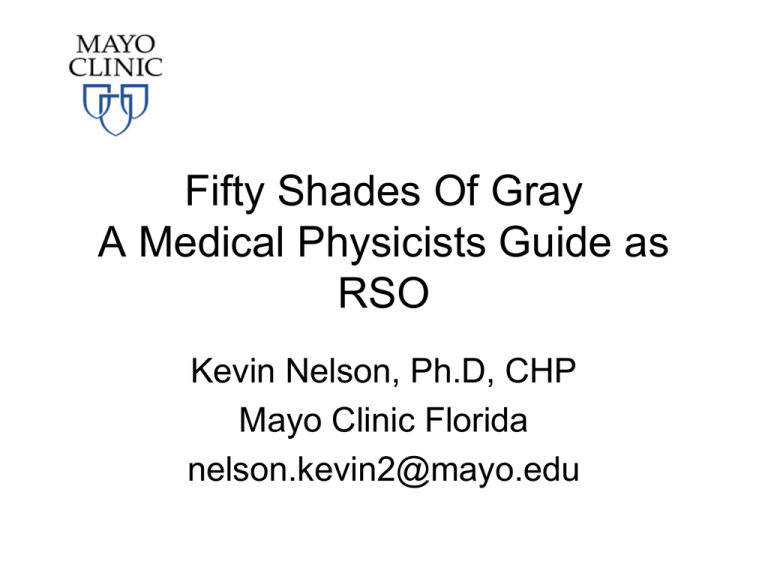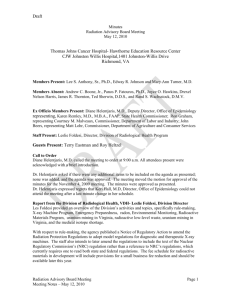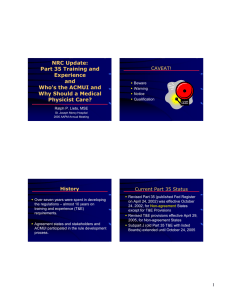Fifty Shades Of Gray A Medical Physicists Guide as RSO
advertisement

Fifty Shades Of Gray A Medical Physicists Guide as RSO Kevin Nelson, Ph.D, CHP Mayo Clinic Florida nelson.kevin2@mayo.edu Objectives • Review training and education requirements for a Radiation Safety Officer • Obtain a better understanding of typical regulatory issues encountered in the medical use of byproduct material • Review recent NRC enforcement actions against medical use licensees Major Regulations and Guidance • 10 CFR 19 – Notices, Instructions and Reports To Workers • 10 CFR 20 – Standards For Protection Against Radiation • 10 CFR 35 – Medical Use of Byproduct Material • NUREG-1556, Vol. 9, Rev. 2 "Consolidated Guidance about Materials Licenses: ProgramSpecific Guidance about Medical Use Licenses," January 2008 – describes types of information needed to complete NRC Form 313, "Application for Material License" and NRC Form 313A, "Training and Experience and Preceptor Statement." – The “How To” document Medical Facility RSO Requirements • Certified by specialty board recognized by NRC or agreement state – Hold bachelor’s or graduate degree from accredited college or university and have at least 20 credits in physical science • Have at least 5 years professional experience in health physics (graduate training may account for up to 2 years) – Hold master’s or doctor’s degree in physics, medical physics, other physical science, engineering or applied mathematics from accredited college or university • Have at least 2 years full time practical training and/or supervised experience in medical physics RSO Requirements Medical Facility RSO Requirements • or, • 200 hours didactic training • One year of full-time radiation safety experience under supervision of an individual identified as an RSO on a license Medical Facility RSO Requirements • or, • Medical physicist certified by specialty board recognized by NRC or agreement state, or an authorized user, authorized medical physicist or authorized nuclear pharmacist identified on the licensee’s license, and, – Has experience in radiation safety for similar types of use of byproduct material for which licensee is approved or seeking approval Medical Facility RSO Requirements • Applies to all pathways • Has obtained written attestation signed by preceptor RSO that the individual has achieved a level of radiation safety knowledge to function independently as RSO, AND, • Has training in radiation safety, regulatory issues and emergency procedures for the types of use for which the licensee has/seeks approval 10 CFR 19 • Notifications and Reports to Individuals – NRC Form 3 posted? – Radiation exposure summaries must be provided in a written report to workers on an annual basis and include the statement, “This report is furnished to you under the provisions of _________. You should preserve this report for further reference”. 10 CFR 20 • Develop, document and implement a radiation protection program sufficient to ensure compliance with 10 CFR 20 • Individual monitoring required at 10% of limits • Radioactive gases and aerosols – must post re-entry times – location of posting • Security – secure from unauthorized removal or access licensed sources of radiation that are stored in restricted or unrestricted areas Unsealed Byproduct Material Written Directive NOT Required • Ensure Clinical Procedures Manual (CPM) contains all required elements • Ensure your actual administered dosages match CPM range • Does linearity check cover actual activity range? • Are syringe shields used? extremity dosimeters? • Is decay-in-storage being documented correctly? Unsealed Byproduct Material – Written Directive NOT Required • Diagnostic clinical procedures manual – collection of written procedures that describes each method by which the licensee performs diagnostic clinical procedures; where each diagnostic clinical procedures has been approved by the authorized user and includes the radiopharmaceutical, dosage and route of administration, or in the case of sealed sources for diagnosis, the procedure Can Your Nuc Med Techs Answer The Following Questions? • When do you use a syringe shield? • Is a written script required for all patients? under what circumstances is a written directive not required? • What is required on a written directive? • How can you determine if a physician is an authorized user? • Where can you find dosing information for a procedure? • What should you do if you question a procedure? Can Your Nuc Med Techs Answer The Following Questions? • What is done to assure the correct patient is receiving the correct exam? • What surveys are required for all incoming packages? • What is “TI”? how is it measured? • What sequence should occur before a survey meter is used? • When is an ambient survey performed? wipe test? Patient Pregnancy Determination • Posted signage – Joint Commission • Patient questioning – “No” – “Yes” – “Maybe” • Adolescent patient/parent issues • Non-digital home pregnancy test unreliable • Mean age of menopause in US = 51 years Patient Pregnancy Determination • Deterministic effects – not seen < 50 mGy • Stochastic effects – childhood malignancy (particularly leukemia) – bkg rate doubles at 10 mGy • At Mayo, for women of childbearing age and able to conceive, test for all radiopharmaceutical therapies and offer testing for fetal high dose diagnostic procedures, e.g., abdominal/pelvic CT Manual Brachytherapy • NRC definition – therapeutic medical use approved in the Sealed Source and Device Registry or with active IDE • Some agreement states list approved isotopes and uses, e.g., 60Co, 90Sr. 103Pd, 125I, 137Cs, 192Ir, 198Au, 222Rn, 226Ra, 131Cs • Survey record of sources remaining after implant • Survey records of patient post-removal 90Y • • • • • • Microspheres Considered a brachytherapy source Used to treat unresectable HCC TheraSpheres® – glass beads SIRSpheres® – resin beads Stasis IR’s may be authorized users 90Y Microspheres (con’t) Radiopharmaceutical Therapy • Capsular vs liquid 131I • Radiopharmaceutical therapy or permanent implant patient release – limit home occupants to < 5 mSv; members of the general public to < 1 mSv (10 CFR 35) • Provide written instructions – differences between retention Patient Instructions Sisson, J.C., et, al, Radiation safety in the treatment of patients with thyroid diseases by radioiodine 131I: Practice recommendations of the American Thyroid Association, Thyroid, Vol 21 (4), 335-346. Record Retention • Until license termination – personnel dosimetry records (external and internal); Long lived waste disposal (bio-molecular research 3H, 14C) • 5 years – authority, duties and responsibilities of RSO; changes in radiation protection program; minutes of Radiation Safety Committee Record Retention • 3 years – written directives; dose calibrator checks (some may be required to be held longer); radiation survey instrumentation calibration; administered dosage of unsealed byproduct material; generator breakthrough tests; leak tests; semi-annual physical inventory of sealed sources; surveys for ambient radiation exposure rate; radiation patient release records; mobile medical service authority and responsibilities; radiation safety training; surveys after source implant and removal; brachytherapy source accountability; calibration measurements of brachytherapy sources; installation, maintenance and repair records for HDR, teletherapy and gamma stereotactic units; ……… Electronic vs. Hard Copy • Know your inspectors!! Copies of Vendor Licenses • • • • • Radiopharmaceutical supplier HDR supplier LDR source supplier 57Co flood source supplier Gamma camera attenuation correction source supplier • Must have current copy General Administrative Requirements • Written documentation be provided describing the elements that compose the radiation safety program General Technical Requirements • Testing for Leakage or Contamination of Sealed Sources (e.g., 57Co flood sources, LDR) • Leak tested at intervals not to exceed six months • Must be capable of detecting the presence of 0.005 µCi on test sample • Exemptions are allowed for small activity sources General Technical Requirements • Ambient radiation dose rate survey – Required in all areas where radioactive material requiring a written directive is prepared for use or administered – Must be able to measure dose rates as low as 0.1 mrem/hr. Record must be maintained for 3 years and include date of survey, results of survey, instrumentation used and name of person performing survey. – Survey required once a week in all areas where radioactive drugs or radioactive wastes are stored. Must be able to measure dose rates as low as 0.1 mrem/hr. Record must be maintained for 3 years and include date of survey, results of survey, instrumentation used and name of person performing survey. – Must establish dose rate action levels • Contamination survey – Required each week in all use and storage areas. Must be able to detect 2000 dpm. Record must be maintained for 3 years and include date of survey, results of survey, instrumentation used and name of person performing survey. – Must establish contamination action levels General Technical Requirements • Possession of Survey Instrument – must possess a portable radiation detection survey instrument capable of detecting dose rates from 0.1 mrem/hr to 50 mrem/hr • Shall be calibrated before first use, annually and after repair • Calibrate all required scale readings up to 1000 millirem/hr with a radiation source. • Calibration intervals must not exceed 12 months • Licensee shall check each survey instrument for consistent response with a dedicated check source before each use • Calibration records must be kept for three years. Record must include the model and serial number of the instrument, date of calibration, results of calibration and name of individual performing the calibration. General Technical Requirements • Storage and decay limited to T1/2 < 120 days • 57Co T1/2 = ? Radiation Safety Training • Personnel who work with radioactive material are required to be training on hire and annually thereafter. – Nuc Med – Rad Onc – Nursing – Housekeeping Radiation Safety Training • Records of training must be kept for 3 years and include a list of topics covered, the date of instruction or training, the name(s) of the attendee(s) and the name(s) of the instructor. QMP • Quality Management Program review of programs that deliver doses to patients using byproduct material • Not part of NRC requirements but still exists in some agreement states • Required to be conducted annually DOT Requirements – 49 CFR • For non-exempt, non-limited quantity incoming shipments, the licensee is required to keep a copy of the DOT Type A shipping container certification. • DOT Hazardous Material (HAZMAT) training is required to be conducted every three years for all individuals involved in the receipt and packaging of hazardous materials. As of March 25, 2003, DOT has required that security be addressed in their HAZMAT training requirements. DOT Requirements • Copy of all current Type A package test certifications that are sent from your facility Security • The Hot Lab door must be secured when staff are not present • Joint Commission has been asking to see hospital policies regarding the delivery of radioactive material to the nuclear medicine department by outside providers. Make sure this is included in your policies. Security • Nationally Tracked Sources • Irradiators; gamma stereotactic units • 137Cs - Category 1 threshold – 2700 Ci; Cat 2 threshold – 27 Ci • Enhanced security – enclosed room, limited access, FBI fingerprinting and bkg checks • Annual on-line NRC National Source Tracking System • Area of increased regulatory focus USP-797 • Hot Lab cleanliness and sterility of kit preparations in nuclear medicine has come under closer scrutiny with the issuance of USP-797 guidelines. • Exemptions are allowed if a single kit is prepared for a single patient and used within an hour. • Sterile prep area and proper air flow required Reciprocity • General license is issued for licensed authorized users from outside of state to practice for a period not to exceed 180 days in any calendar year NRC Significant Enforcement Actions • http://www.nrc.gov/aboutnrc/regulatory/enforcement/current.html NRC Significant Enforcement Actions/Violations – Medical Licensees – 2007-2012 Year Total 2007 2008 2009 2010 2011 2012 Failure to develop, implement and maintain written procedures to provide high confidence that each administration will be done in accordance with the written directive 1 3 1 8 3 3 19 Failure to control and maintain constant surveillance of licensed material that is in a controlled or unrestricted area. Radioactive material left unsecured and unattended. Failure to secure from unauthorized removal or limit access to a HDR. Failure to secure from unauthorized removal or access licensed materials that are stored in controlled or unrestricted areas 2 2 3 3 2 0 12 Failure to report a medical event/lost source no later that the next calendar day after discovery. 1 1 1 3 2 0 8 Failure to ensure an authorized user was physically present during initiation or continuation of a HDR or gamma stereotactic patient treatment 1 1 1 1 1 0 5 Violation NRC Significant Enforcement Actions/Violations – Medical Licensees – 2007-2012 Year Total 2007 2008 2009 2010 2011 2012 Written directive not signed and dated by the authorized user prior to treatment 1 1 0 1 0 0 3 Failure to verify treatment was conducted in accordance with written directive/treatment plan 1 0 0 2 0 0 3 Failure to conduct surveys to ensure compliance 0 1 1 0 0 0 2 Failure to wear finger dosimetry while compounding I131 0 0 1 0 0 0 1 Discharge of licensed material into sanitary sewer exceeded concentration limits 0 0 1 0 0 0 1 Failure to file reciprocity agreement 0 0 0 1 0 0 1 Failure to have appropriate procedures in place for an administration requiring a written directive 0 0 0 1 0 0 1 Failure to properly instruct individuals about procedures, regulation, license conditions and prompt event reporting 0 0 0 1 0 0 1 Failure to report change in RSO in timely manner 0 0 1 0 0 0 1 Inaccurate personnel information supplied to NRC 1 0 0 0 0 0 1 Violation



